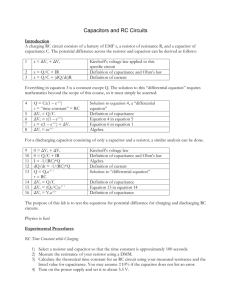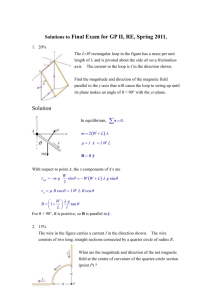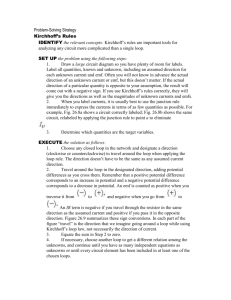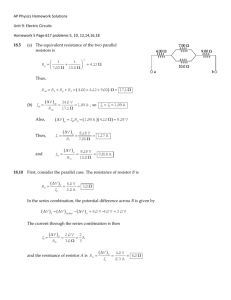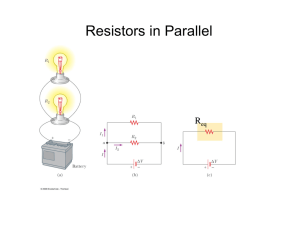21.8 Kirchhoff’s Rules for Complex DC circuits
advertisement
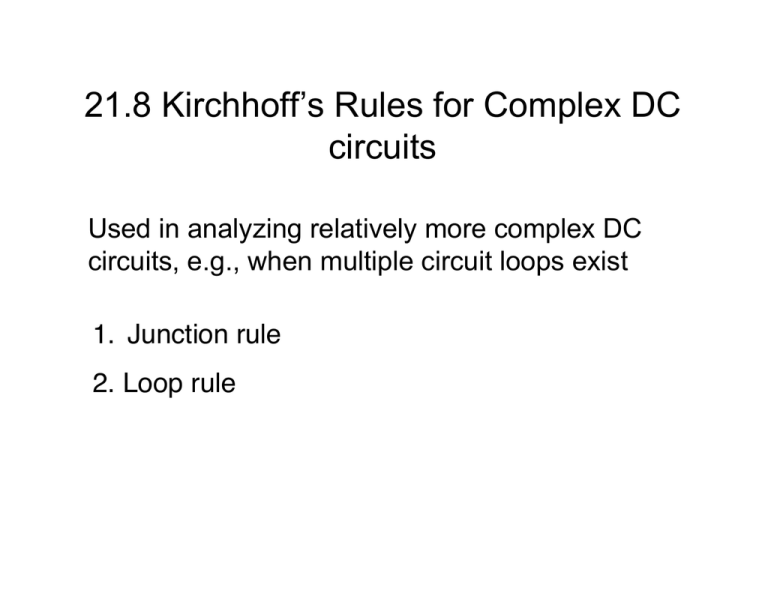
21.8 Kirchhoff’s Rules for Complex DC circuits Used in analyzing relatively more complex DC circuits, e.g., when multiple circuit loops exist 1. Junction rule 2. Loop rule Junction Rule Sum of currents entering any junction must equal the sum of the currents leaving that junction: I1 = I2 + I3 A consequence of conservation of charge (charge can’t disappear/appear at a point) Loop Rule C R1 B D ε E A R2 F +ε – IR1 – IR2 =0 ε = IR1 + IR2 “The sum of voltage differences in going around a closed current loop is equal to zero” Stems from conservation of energy Application of Loop Rule Choose a current direction (a to b) When crossing a resistor: ΔV = – IR in traversal direction When crossing a resistor: ΔV = + IR in opposing direction When crossing a battery: – to + terminals: ΔV = +ε When crossing a battery: + to – terminals: ΔV = –ε Example of loop/junction rules R1 A I1 I2 R2 Example of loop/junction rules R1 A I1 I2 R2 Loop rule: Start at point A, go in CW direction: –I1R1 + I2R2 = 0 I1R1 = I2R2 I1/I2 = R2/R1 Example of loop/junction rules R1 A Itot = 1.0 A I1 Suppose Itot = 1.0 A, R1 = 3 Ω and R2 = 6Ω. I2 Find I1 & I2. R2 I1/I2 = R2/R1 = 2 or, I1 = 2I2 But I1 + I2 = Itot = 1.0A. 2I2 + I2 = 1.0 A So I2 = 0.33 A, and I1 = 0.67 A. Example of loop/junction rules Req Now, calculate ε of the battery. 1/Req = 1/(3Ω) + 1/(6Ω) = 1/(2Ω) Req = 2Ω Itot = 1.0 A Loop rule for simplified circuit: ε= Itot Req = 1.0 A 2Ω = 2.0 V ε Example of loop/junction rules R1 A I1 Confirm that the amount of the voltage drop across each resistor is 2V: I2 Itot = 1.0 A R2 ε=2V ΔV1=I1R1 = (0.67A)(3Ω) = 2V ΔV2 = I2R2 = (0.33A)(6Ω) = 2V. Loop rule, cont’d ε2 Another example: R3 R4 ε1 In which direction will the current flow? Loop rule, cont’d ε2 Starting at point A, and going with the current: +ε1 – IR3 + ε2 – IR4 = 0 R3 R4 +ε1 + ε2 – IR4 – IR3 = 0 +ε1 + ε2 = IR4 + IR3 A ε1 Another example: ε2 But watch the direction of EMF in batteries: R4 Starting at point A, and going with the current: R3 +ε1 – IR3 – ε2 – IR4 = 0 A ε1 +ε1 – ε2 – IR4 – IR3 = 0 +ε1 – ε2 = IR4 + IR3 How to use Kirchhoff’s Rules • Draw the circuit diagram and assign labels and symbols to all known and unknown quantities • Assign directions to currents. • Apply the junction rule to any junction in the circuit • Apply the loop rule to as many loops as are needed to solve for the unknowns • Solve the equations simultaneously for the unknown quantities • Check your answers -- substitute them back into the original equations! Example for Kirchhoff’s Rules: #21.35 . Point A 21.9 RC Circuits Introduction to time-dependent currents and voltages. Applications: timing circuits, clocks, computers, charging + discharging capacitors An RC circuit Battery, Capacitor, Resistor and switch connected in series. Initially, the capacitor is uncharged. We’re about to close the switch and allow the capacitor to start charging… RC circuit: charging At time t=0, close Switch An RC circuit At time t=0, close switch Initially (at t=0), Q = 0. ΔVC (at t=0) = Q(t=0) / C = 0 Loop Rule: ΣΔV=0 = +ε - ΔVR - ΔVC +ε - IR - ΔVC = 0 So when charge = 0 (which occurs at t=0), ε = IR and so the current I jumps immediately up to ε/R (at this instant, capacitor has no effect) RC circuit: charging Immediately after time t=0: Current starts to flow. Charge starts to accumulate on Capacitor (at a rate I=dQ/dt). As Q increases over time, ΔVC =Q/C also increases. But remember ΔVC + ΔVR = ε. So ΔVR is decreasing over time. And I through the resistor = ΔVR/R is also decreasing. RC circuit: charging After a very long time: Charge accumulates until Q reaches its maximum: ΔVC goes to ε. Total Q on the capacitor goes to Cε. +ε = ΔVC + ΔVR ΔVR goes to zero. And I goes to zero. RC circuit: charging I(t): Q(t): ε/R 0.368 ε/R t τ=RC t=0 ΔVC 0 Q 0 ε(1–e–(t/τ)) Cε(1–e–(t/τ)) ΔVR ε ε/R ε(e–(t/τ)) (ε/R)(e–(t/τ)) Ι t∞ ε Cε 0 0 Exponential decay Rate of decay is proportional to amount of species. Other applications: Nuclear decay, some chemical reactions Atmospheric pressure decreases exponentially with height If an object of one temperature is exposed to a medium of another temperature, then the temperature difference between the object and the medium undergoes exponential decay. Absorption of electromagnetic radiation by a medium (intensity decreases exponentially with distance into medium) Time constant τ = RC RC is called the time constant: it's a measure of how fast the capacitor is charged up. It has units of time: RC = (V/I)(q/V) = q/I = q / (q/t) = t At t = RC, Q(t) and ΔVC(t) go to 1 – 1/e = 0.63 of the final values At t= RC, I(t) and ΔVR(t) go to 1/e of the initial values Time constant τ = RC Think about why increasing R and/or C would increase the time to charge up the capacitor: When charging up: τ will increase with C because the capacitor can store more charge. Increases with R because the flow of current is lower. Time constant τ = RC You want to make a flashing circuit that charges a capacitor through a resistor up to a voltage at which a neon bulb discharges once every 5.0 sec. If you have a 10 microfarad capacitor what resistor do you need? Solution: Have the flash point be equal to 0.63 ΔVC,max τ = RC R = τ/C = 5s/10-5F = 5 ×105 Ohms This is a very big resistance, but 5 seconds is pretty long in "circuit" time

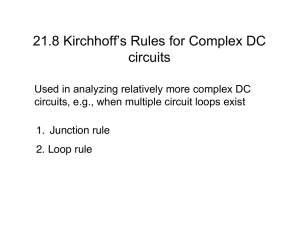
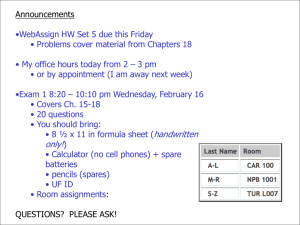
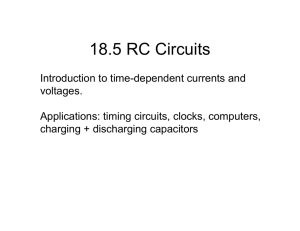
![Sample_hold[1]](http://s2.studylib.net/store/data/005360237_1-66a09447be9ffd6ace4f3f67c2fef5c7-300x300.png)
